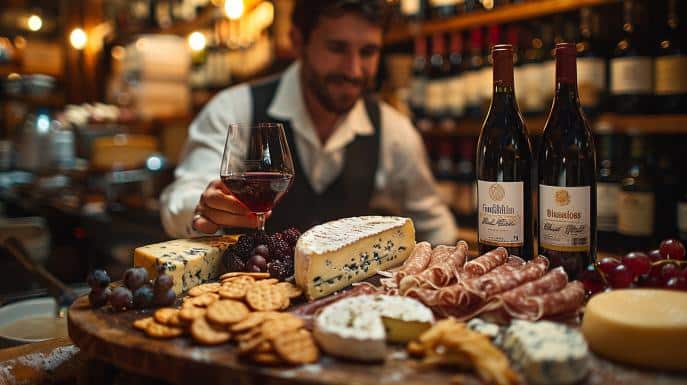Já se perguntou como elevar sua experiência gastronômica a um novo patamar de prazer? No coração deste enigma está a arte da harmonização de vinhos—uma dança delicada entre sabores que pode transformar uma simples refeição em um evento memorável. Em “Guia de Harmonização de Vinhos: Dicas Simples”, desbravamos o mundo da combinação perfeita. Descobriremos juntos os segredos da harmonização entre vinhos e alimentos, os princípios de combinação de vinhos que garantem um casamento de aromas e texturas, e até mesmo como o par ideal pode realçar os sabores e criar um equilíbrio entre seu prato e sua taça. Preparado para tornar-se um mestre na harmonização de vinhos? Degustemos juntos este guia.
Por que a harmonização de vinhos é essencial para uma experiência gastronômica completa?
A harmonização entre vinhos e alimentos é crucial pois intensifica os sabores do prato. Vinhos com peso equivalente ao do prato, como um tinto encorpado com uma carne assada, criam um equilíbrio perfeito na boca. A acidez de certos vinhos pode cortar a gordura de pratos mais ricos, enquanto os taninos suavizam ao entrar em contato com proteínas, realçando a comida e a bebida simultaneamente.
Quais são as melhores combinações de vinhos e alimentos?
A química entre vinhos tânicos e pratos ricos em proteínas cria combinações perfeitas, como Cabernet Sauvignon e um suculento bife. Vinhos ácidos, como um Chardonnay vibrante, são o par ideal para pratos gordurosos, cortando a gordura e equilibrando a boca. E sim, vinhos doces e pratos apimentados podem harmonizar-se; um Riesling doce contrabalanceia o picante, prevenindo a sensação de ardência. Explore exemplos de harmonização perfeita para inspiração e direção.
Quais são as regras básicas para selecionar um vinho para diferentes tipos de queijos e sobremesas?
Para harmonizar vinhos e queijos, a intensidade deve ser sua bússola. Vamos desvendar a verdade sobre o vinho e sobremesas: sim, o vinho deve ter doçura igual ou superior à sobremesa. Pares ideais seguem a regra de que sabores intensos de queijo demandam vinhos robustos, enquanto queijos mais suaves combinam com vinhos leves. Com sobremesas, um Vinho do Porto com chocolate é sublime porque o vinho é tão doce quanto o doce. A chave para uma harmonização bem-sucedida é equilibrar os perfis de sabor sem que um domine o outro.
Como escolher vinhos para ocasiões especiais e pratos regionais?
A harmonização de vinhos e pratos regionais segue o adágio: o que cresce junto, vai junto. Este princípio é o alicerce para escolhendo vinhos para ocasiões especiais, pois celebra a conexão entre a culinária local e as uvas da região. Ao preparar um jantar com pratos de uma área específica, optar pelo vinho local pode realçar sabores que foram evoluindo juntos ao longo do tempo. Técnicas de cozimento, como defumar ou grelhar, influenciam o perfil do vinho escolhido; vinhos com notas defumadas complementam pratos grelhados. Além disso, a escolha de vinhos não precisa ser dispendiosa; com um guia para iniciantes em vinhos, é possível encontrar opções de excelente relação custo-benefício que engrandecem a experiência sem comprometer o orçamento.
Neste artigo, exploramos a arte essencial da harmonização de vinhos, desde o realce de sabores até a sólida relação entre comida e bebida. Abordamos como a escolha apropriada do vinho pode intensificar uma refeição, balanceamento de peso entre pratos e vinhos, e o impacto de acidez e taninos. Além disso, discutimos combinações específicas para alimentos variados, regras básicas para queijos e sobremesas, e dicas para selecionar vinhos em ocasiões especiais e pratos locais. Harmonizar vinhos não é apenas ciência, mas uma arte que enriquece a experiência gastronômica, convidando-nos a saborear cada momento à mesa com profundidade e satisfação.
FAQ
Por que é importante combinar vinhos com alimentos?
A combinação ideal de vinhos e alimentos intensifica os sabores do prato, criando um equilíbrio perfeito nos sabores e texturas. Vinhos são selecionados para complementar ou contrastar com a comida, realçando a experiência gastronômica.Quais são algumas combinações de vinhos e alimentos recomendadas?
Recomenda-se combinar vinhos tânicos como o Cabernet Sauvignon com pratos ricos em proteínas como bifes, e vinhos ácidos como o Chardonnay com pratos gordurosos para equilibrar a sensação na boca. Vinhos doces como o Riesling também podem harmonizar com pratos apimentados, suavizando a picância.Como seleciono vinhos para acompanhar queijos e sobremesas?
Ao selecionar vinhos para queijos e sobremesas, deve-se igualar a intensidade dos sabores. Queijos mais intensos pedem vinhos robustos, enquanto queijos suaves combinam melhor com vinhos leves. Para sobremesas, escolha um vinho com doçura igual ou superior à do prato, como um Vinho do Porto com chocolate.
- Que diretrizes devo seguir ao escolher vinhos para pratos regionais ou ocasiões especiais?
Para pratos regionais, o princípio de que “o que cresce junto, vai junto” orienta a escolha de vinhos locais que possam complementar a culinária da região. Em ocasiões especiais, selecione vinhos com perfis que harmonizem com as técnicas de cozimento e ingredientes utilizados, mantendo sempre em mente a relação custo-benefício.



